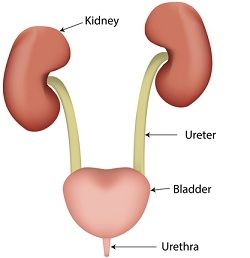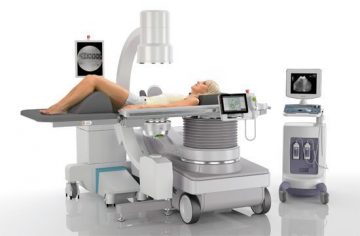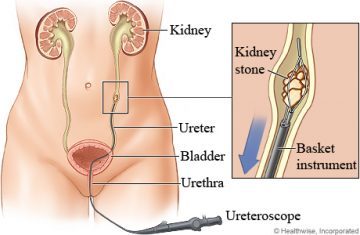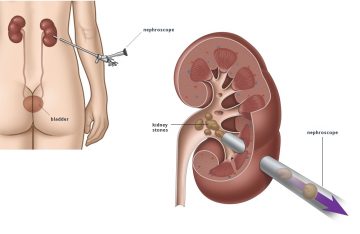What should I expect after getting my first stone?
Kidney stones are a condition with unique and complex symptoms, each stone case will have specific challenges and problems for each patient.4 Typically when you first start to pass a stone the pain will appear quite harsh and suddenly. This pain might come in waves and you will feel the stone as it travels through your ureter into your bladder and out your urethra.
There are some stones that may remain in your kidney for extended periods of times without causing any symptoms. Some stones may also get embedded in your kidney tissue and will therefore not pass naturally. Routine checkups are required to monitor the status of asymptomatic stones to ensure that the stone is not growing or causing any blockage from the kidney to the ureter. If the stone does end up blocking the passage from the kidney to the ureter or any part of the ureter this can cause kidney damage if left for a long time.
What can I do to prevent kidney stones?
There are different types of kidney stones and each stone has a different root cause and different way of being prevented.
However, the single best way to combat and prevent ALL types of kidney stones is to drink lots of water. For more info on how much water you should be drinking please click here.
What treatments are available for kidney stones?
The three main methods of treatment for kidney stone disease:
- Extracorporeal Shock Wave Lithotripsy (ESWL)
- Ureteroscopy (URS)
- Percutaneous Nephrolithotomy (PCNL).

ESWL uses shock waves produced by a lithotripter machine to break kidney stones into smaller pieces, in hopes that those smaller pieces will be able to pass in the urine. ESWL is a non-invasive procedure that does not require general anesthesia or surgery, but the fragments of the kidney stones produced by the shockwaves have a chance of growing larger again instead of passing and may also potentially cause a blockage.1

URS is more invasive than ESWL, requiring a fibre optic tube being passed up the urethra to the ureter. The stone is located and then removed using one of two different techniques. A laser can be used to break up the stone into very small pieces so that this can pass naturally. Alternatively, the stone can be caught in a “basket” at the end of the ureteroscope and then removed through the urethra in one piece.1
PCNL is the most invasive technique, involving the insertion of a needle into the kidney at the site of the stone. The incision is enlarged to about 1.5 cm, and a tool is inserted into the kidney to fragment the kidney stone. The fragments are taken out by a vacuum through the incision. Unlike ESWL and URS, very few to no fragments remain, which is why PCNL is the procedure of choice for very large stones. PCNL is an in-patient procedure, requiring patients to stay the night at the hospital.1

For more detailed info on treatments please click here.
Are there any effective alternative options to these treatments?
Once you have a kidney stone, there are not many alternative methods to these treatments if your stone does not naturally pass. However, many preventative measures may be taken, such as proper dietary management, usually recommended by your urologist.2 Diet recommendations may change depending on what type of kidney stones you have. For example, recent studies have shown a possible link between increased citrate consumption and decreased frequency of calcium oxalate and calcium phosphate stones.2
Making sure you drink enough water is the easiest and most important way to reduce the chance of recurring kidney stones.
For more information on dietary management of kidney stones please click here.
What medications are available to manage my symptoms?
It should be noted that the first line of treatment for managing kidney stone disease is dietary modification, not medication.2 However medications like thiazide diuretics and potassium citrate can help with kidney stone disease depending on certain risk factors.7
Thiazides lower urinary calcium and prevent acidic urinary pH. Potassium citrate also helps prevent acidic urinary pH which in turn inhibits stone formation.7 Consult with your urologist to see if these medications are a good fit for you.
How long do I need to wait to get treated?
This all depends on the severity of your symptoms, the clinic at which you are treated, and the type of treatment you are receiving. Some stones may go unnoticed for years as a result of lack of symptoms – as is usually the case for stones that get embedded in the tissue of the kidney. Some stone cases may cause blockages from the kidney to the ureter or along the ureter, these stones need to be removed as soon as possible to prevent kidney damage.
Each stone burden is unique and depending on how it is affecting the health of the kidney and the patient, treatment times will vary.
How often do they recur?
Recurrence of kidney stones varies from person to person. Studies have stated a 50% recurrence rate over 5-10 years, or 75% over 20 years.2
However, with the correct preventative measures such as proper hydration, the recurrence of kidney stones can be decreased. Previous studies have shown that increased fluid intake after a stone episode can decrease stone recurrence by as much as 15% when compared to patients who kept the same level of fluid intake.6
How prevalent are kidney stones in the general population?
Kidney stones occur on average in 1 in 10 Canadians over a lifetime, and 1 in 7 Americans.3 Men are two times more likely to form kidney stones than women. Later in life, the likelihood of women getting kidney stones increases.
What causes kidney stones?
Kidney stones are formed as a result of the crystallization of components of the urine. The kidney’s job is to filter out waste into the urine while minimizing water loss. As a result, urine is very concentrated- there is a lot of waste in only a little water. Because there are so many waste molecules in the urine, with the right conditions, the molecules may crystallize out, just like salt crystals from sea water.1 These crystals form kidney stones.
This crystal formation can have multiple root causes, such as genetic, dietary and infection related components. Each stone type is usually indicative of a different root cause, however, drinking water is still best way to prevent stones of all types.
What types of stones are there?
The main types of stones include Calcium Oxalate stones, Struvite stones and Uric Acid Stones. Other rare stone types include cysteine and xanthine stones.
Calcium Oxalate stones, or calcium containing stones, make up 70-80% of all kidney stone cases.1 Calcium oxalate stones can be caused by diets that are high in oxalate. This however can be remedied by pairing high oxalate foods with calcium containing foods.
Struvite stones make up 10% of all kidney stone cases, and are caused by bacteria that are present in the bladder/kidneys. The bacteria cause kidney stones by making their own waste products that crystallize and form stones.
Uric Acid stones make up 7% of all kidney stone cases, and are influenced by alcohol consumption, fructose ingestion and obesity.1 Gout is a disease that is also characterized by high levels of uric acid; however with gout, the uric acid in your blood crystallizes around your joints causing arthritis symptoms.
Cysteine stones make up 2% of all kidney stone cases and are due to a genetic disorder resulting in large amounts of cysteine in the urine.1 The precise causes of cysteine stones have yet to be discovered. The final 1% of kidney stone cases include stones such as Xanthine stones. These stones are quite rare and as a result have not been as well studied.1
For more info on the different stone types and how they can be prevented through your diet please click here.
What kind of tests provide the best information to guide me in my food and lifestyle choices?
Two main tests, a 24-hour urine (metabolic work up) and a stone composition analysis can provide a great deal of information on the nature of your kidney stone and therefore how to best treat it.
A 24-hour urine test keeps track of what type of waste products you produce in your urine, and how much of that waste product is produced over the course of a day. This is important because it identifies which compounds are abnormally high or low, and you can then change your diet accordingly.3
The stone composition analysis gives information on what compounds make up your stones. Knowing what type of stone you have is important, as effective treatment differs depending on the type of stone. For example, eating less oxalate will not be effective for preventing a struvite stone but will be helpful in preventing formation of a calcium oxalate stone.
What is a metabolic work up or 24-hour urine collection?
A metabolic workup refers to special urine and blood tests that determine whether a modified diet or medication(s) are necessary to help reduce the chance of kidney stone recurrence.
Part of a detailed metabolic work up is a 24-hour urine collection – where you collect all your urine over 24 hours and then have it analyzed by a lab. A 24-hour urine provides useful information on the different levels of components in your urine such as calcium, oxalate, phosphate, uric acid, and citrate. If any of these components are outside normal levels then this may provide more information on the cause of your kidney stone. Metabolic workups allow stone care specialists to shape nutrition and diet recommendations such that they are tailored to individual patients.5
For example: having an high urinary oxalate content along with a calcium oxalate stone may suggest that you need to increase your calcium intake to cancel out the effects of the oxalate.
Is having a kidney stone episode a life-threatening event?
Although often uncomfortable, kidney stone episodes are rarely life-threatening. Rare exceptions include kidney failure caused in patients with only one functioning kidney being blocked by a stone, or blockages resulting in sepsis (a blood infection).
Where can I learn more about kidney stones?
There are many free patient resources available on the web, including the Stone Centre Website, the Canadian Urological Association, the UBC Department of Urologic Sciences, and the Urology Care foundation. Links to all of these websites can be found below.
At the stone centre website you can find information on the kidneys, kidney stone treatment options, dietary advice for specific types of stone as well as real patient experiences with kidney stones. We also post relevant info about recent kidney stone discoveries as well as patient information events on our website.
References
- Steggall MJ, Omara M. Urinary tract stones: types, nursing care and treatment options. Br J Nurs. 2008;17(9):s20-3.
- Moe OW. Kidney stones: Pathophysiology and medical management. Lancet. 2006;367(9507):333-344. doi:10.1016/S0140-6736(06)68071-9.
- Milose JC, Kaufman SR, Hollenbeck BK, Wolf JS, Hollingsworth JM. Prevalence of 24-hour urine collection in high risk stone formers. J Urol. 2014;191(2):376-380. doi:10.1016/j.juro.2013.08.080.
- Shah S and Calle JC: Dietary and medical management of recurrent nephrolithiasis. Cleveland Clinic Journal of Medicine. 2016; 83: 463
- Milose JC, Kaufman SR and Hollenbeck BJ et al: Prevalence of 24-Hour Urine Collection in High Risk Stone Formers. J Urol. 2013; 191: 376
- Borghi, L., Meschi, T., Amato, F., Briganti, A., Novarini, A., & Giannini, A. (1996). Urinary Volume, Water and Recurrences in Idiopathic Calcium Nephrolithiasis. The Journal of Urology, 839-843. doi:10.1097/00005392-199603000-00009
- Dion M, Ankawi G and Chew B et al: CUA guideline on the evaluation and medical management of the kidney stone patient – 2016 update. Can Urol Assoc J. 2016; 10: 347
